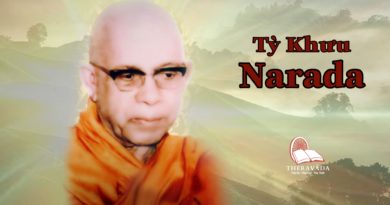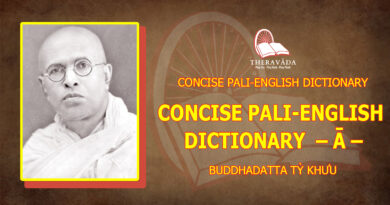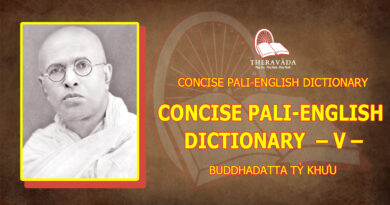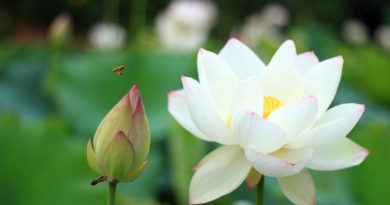VIPASSANA MEDITATION – CHAPTER 5: THE SEVEN STAGES OF PURIFICATION
VIPASSANA MEDITATION – CHAPTER 5: THE SEVEN STAGES OF PURIFICATION
Part 1 – Purification Of Moral Conduct
The first is sila visuddhi, Purification of Moral Conduct. Meditators have to observe at least five precepts, if not eight, so that they can attain purification of sila. The third of the five precepts is abstention from sexual misconduct, whereas the third of the eight precepts is abstention from all kinds of sexual contact. If a meditator does not abstain from sexual contact, his mind will be defiled by the hindrance of sense desire kamacchanda nivarana). Only when the mind is purified from all hindrances can meditators realise mental and physical processes in their true nature.
Of course it is better if meditators can observe the eight precepts. If they do not, they may have desires for taste, food, visible things, audible things, odours and tangible things – five kinds of sense desire (kammacchanda) in their mind. By observing eight precepts, one can purify ones deeds and speech which is purification of moral conduct (Citta visuddhi). When moral conduct is purified, the mind is also purified to some extent.
When the mind becomes purified, it becomes calm, serene, tranquil and happy and can concentrate on the object of meditation. Then the meditator attains Purification of Mind, i.e. Citta visuddhi the second stage of purification.
When Venerable Uttiya, one of the disciples of the Buddha was sick in bed, the Buddha visited him and asked about his health. Venerable Uttiya told the Buddha about his sickness:
Venerable sir, my sickness is not decreasing but increasing. I do not know whether I can or cannot live out today or tomorrow. So I want to meditate to destroy all kinds of defilements through to the fourth stage of enlightenment, arahantship, before I die. Please give a short instruction which will enable me to develop my meditation practice to attain Arahantship.
Then the Buddha said:
Uttiya, you should cleanse the beginning. If the beginning is purified, then you will be all right, i.e. able to attain Arahantship.
The Omniscient Buddha asked the question, “What is the beginning?” He himself replied, “Herein the beginning is purified moral conduct or sTia and right view (Samma ditthi). Right view means the acceptance of and belief in the Law of Cause and Effect (action reaction) or the Law of Kamma.” The Omniscient Buddha continued:
Uttiya, you should cleanse your moral conduct and right view. Then, based on the purified moral conduct or Sila, you should develop the Four Foundations of Mindfulness. Practising thus, you will attain the cessation of suffering.
The Omniscient Buddha lays stress on the purification of sila or moral conduct because it is a basic requirement for progress in concentration as well as insight. When moral conduct is purified, the mind becomes calm, serene and happy. If he cultivates mindfulness, then he can easily concentrate on any object of the mental and physical processes. So purity of moral conduct is a pre requirement for a meditator to make progress.
Part 2 – Purification Of Mind
The second purification is Purification of Mind (Citta visuddhi). If we want to attain insight knowledges, the mind must be purified from all kinds of defilements. When the mind is well concentrated on any mental or physical phenomena, it is free from all these hindrances. This is known as purification of mind – Citta visuddhi. With this purification, the mind can penetrate into the mental and physical processes in their true nature. First of all, he distinguishes between mental process and physical process (nama and rupa) through his own experience. That is known as Namarupapariccheda nana – knowledge of the difference between mentality and physicality.
Part 3 – Purification Of View
The third is Purification of View (Ditthi Visuddhi). When a meditator penetrates into the true nature of mental and physical processes, he does not take them to be a person or a being, a soul or a self. Then he has purified his view, he has attained Ditthi visuddhi.
Part 4 – Purification By Overcoming Doubt
The fourth is Purification by Overcoming Doubt (Kankhavitarana visuddhi). Kankha means doubt, visuddhi means purification by overcoming doubt. When a meditator has attained the second stage of insight knowledge – Knowledge of Cause and Effect (Paccayapariggaha nana), he no longer has doubts about his past existence. Thus, he overcomes doubt. This is purification by overcoming doubt.
To attain this knowledge he has to observe every intention, wish or want before every action or movement. All actions are preceded by intention, wishing or wanting. That is why we have to be mindful of every intention before every action or movement. When we have an intention to lift our foot, we should note it as intending, intending, then lifting, lifting. When we have an intention to bend our arm, we should note intending, intending, then bending, bending. While we are eating, we have an intention to open our mouth to take food, then first of all, we should note intending, intending, then opening, opening. In the act of opening the mouth, the intention is the cause, and the opening of the mouth is the effect.
Without wishing or wanting to come here, could you come here? Then what is the cause and what the effect? The act of coming is the effect, the intention is the cause. Then why do you sit on the chair? Yes, it is the intention that makes you sit on the chair. Is there any sitter? If you think there is a person who sits on the chair, then we should bring a corpse from the hospital and make it sit on the chair.
It cannot sit because there is no intention. It is only intention, the mental process, that causes an action or movement. So is the sitting posture a man or a woman, a samanera or a bhikkhu? It is none of these. In the sitting posture, there is a physical process supported by the wind element (vayyo dhatu – the internal and external wind element). Sitting is a physical process.
So if we want to sit, first of all, we have to note intending, intending, then sitting, sitting, sitting. All the sitting movements must be observed after we have noted intention. When we bend our arm, we must first of all note the intention, then the movements of bending the arm. When we stretch out our arm, first of all, we must note intention, then the movements of stretching as stretching, stretching, stretching. When our concentration is deep enough, by being aware of intention and the actions that follow it, we come to realise that nothing arises without a cause. Everything arises depending on a cause.
Therefore, a so called person, a man or a woman is just the process of cause and effect. There is no doer, no one that does anything. If we believe that there is a person who does the sitting, it is called Sakkaya ditthi or Atta di!tht (wrong view of a doer). If we thoroughly realise the cause and effect relationship, what we realise is just a natural process. Then there is no person that became a president, there is no person that became a king. Then what existed in the past? In the past. there existed only the process of cause and effect. Then we have no doubt about our past existence. In this way, we can overcome doubts about our past existence – so, this is known as purification by overcoming doubt (Kankhavitarana visuddhi).
Some meditators find it difficult to observe intention before every action because they are not patient enough. To observe, we must be patient with our actions or movements so that we can observe the intention before every action or movement. When we observe intention before lifting our foot. we will come to realise how the intention is related to the lifting of the foot. Then again, when we observe intention before the pushing of the foot, we will come to realise how intention is related to the pushing movement of the foot. When we observe the intention before the dropping of the foot, we will also come to realise how the intention is related to the dropping movement of the foot and so on. When we come to realise this relationship of cause and effect, we have almost completely realised the Law of Cause and Effect. By this realisation we overcome doubt as to whether there is any personality or entity which is everlasting in us. Then what really exists is just the process of cause and effect.
Part 5 – Purification Of Knowledge
The fifth visuddhi is Purification of Knowledge and Vision of Path and Non. Path visuddhi). In this stage of insight, you get very good experiences; lightness, happiness, tranquility, serenity etc. Sometimes you may feel your body has become light, as if it has been lifted, or as if you were flying in the sky. Your mindfulness is very keen. Your effort is steady; neither slack nor vigorous, nor rigid. Your effort is moderate, steady and firm. Your concentration is deep, so you experience peace, calmness, serenity, tranquility, happiness, rapture and so on. This is a very good stage that meditators must go through.
This stage may be experienced in about two weeks if meditators practise strenuously, but some meditators go through this stage within a week. With such good experiences, meditators may think This must be nibbana- this is great, I have never experienced it before, it is better than having a million dollars – now I have attained nibbana Thus, he does not go further because he is clinging to it. He thinks that if he goes further, he will go beyond nibbana. If a meditator holds that this stage is nibbana, this is the wrong path. Therefore, he must continue to meditate and practise strenuously. This is only a very minor and trivial experience and he should not be content with it, but must go ahead with his practice.
Part 6 – Purification Of Knowledge
The sixth Visuddhi is Patipada nanadassana visuddhi. Patipadameans the course of practice, nana means knowledge, dassana means vision. Nina and dassana are here referred to in the same sense. In order to lay emphasis on penetration, the text used the two words in the same sense knowledge and vision. So Patipada nanadassana visuddhi means Purification of Knowledge and Vision of the Course of Practice. It means that when we have passed Maggamaggananadassana visuddhi, we are on the right path which leads to Arahantship or the cessation of suffering.
If we were on the wrong path, we would stop at Maggamagga nanadassana visuddhi. Because we are on the right path, we have to go through the nine stages of insight and are approaching the goal, so we can judge that our course of practice is right. Then we do not have any doubt about the course of practice. That doubt has been destroyed by knowledge and vision of the course of practice. Then there is purification of knowledge and vision of the right course of practice – patipada nanadassana visuddhi. When you reach that stage, you have attained Anuloma nana (knowledge of adaptation) because your experience is in conformity with the lower stages of insight knowledge and with the higher stages of insight.
Part 7 – Knowledge Of Maturity
If we continue with our practice, we will come to the borderline in a short time. In two or three thought moments we have reached the line and stand on it. The border here means the border between an ordinary person (puthujjana) and a Noble One (ariya). When you are on the boundary, do you want to go ahead or go back? If you want to go back, your attentions towards the past, but if you want to go ahead your attention is ahead. Ahead is the cessation of compounded things, i.e. the cessation of all kinds of mentality (nama) and physicality (rupa). If you want to proceed, standing on the boundary or border, you look ahead as well as behind. Then you will know, “If I go ahead, all kinds of suffering will cease to exist. So should I go ahead?” You will think about it. The answer is yes, because you have been suffering for many aeons (kappas). The word kappa means countless numbers of existences. When you are at the boundary, you will reflect on your past experiences, “I have been suffering for countless existences in this cycle of dukkha. Ive had enough of this I must put an end to this suffering.”
Your attention is then towards the cessation of suffering. That borderline knowledge is known as Gotrabhu nana. Gotra means Puthujjana or descendants. On this border, descendants of a Puthujjana are cut off totally. Then there is no more Puthujjana. Once you pass that borderline, you become a Noble One (Ariya) because you have cut off the Puthujjana lineage. Venerable Nyanaponika Thera translates it as maturity knowledge or knowledge of maturity because the meditators knowledge is mature enough to attain the path. Actually, we can translate it literally as the knowledge which has cut off the Puthujjana lineage. When the Puthujjana lineage has been cut off, the meditator has attained Sotapatti magga nana – he becomes a Noble One, an Ariya.
Immediately after the borderline knowledge of maturity, there is Path Knowledge (Magga nana) which realises the Four Noble Truths thoroughly:
- Dukkha sacca The Truth of Suffering
- Samudaya sacca The Truth of the Cause of Suffering
- Nirodha sacca The Truth of the Cessation of Suffering
- Magga sacca The Truth of the Way Leading to the Cessation of Suffering
Part 8 – Purification Of Knowledge
The seventh visuddhi refers to Sotapatti nana, the first knowledge of the Path – Nanadassana visuddhi. Nana is knowledge, dassana is vision, visuddhi is purification.
When you have attained the seventh visuddhi you have become a Sotapanna Sota means stream; apanna means enterer. Sotapannameans stream enterer. When you have attained Sotapatti nana, you have entered into the current of the Noble Eightfold Path. Only then have you attained Nanadassana visuddhi – purification of knowledge and vision.









